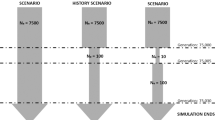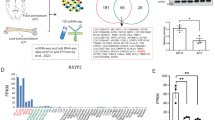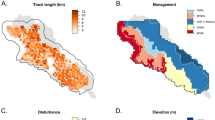Abstract
Morphological characters in red deer ( Cervus elaphus), which serve as criteria for selective hunting, were examined in relation to electrophoretic variation in three populations from the Vosges in eastern France. From the polymorphic loci examined, certain alleles at Idh-2, Me-1 and Acp-1 showed significant associations with a special development of body and antler characters selected for by hunters. Idh-2125 was associated with larger hind foot length in females and a higher number of antler points in males. Me-190 and Acp-1100 were associated with small spikes. The populations studied differed from one another in the duration and intensity of selective hunting and the increase or decrease in the respective allele frequencies could be explained by selection for large body size, a high number of antler points and against small spikes in yearlings, rather than by genetic drift. Among other morphological characters examined, the length of the main beam was significantly associated with the allele Acp-2100. In contrast, no associations could be detected between overall heterozygosity and the development or the degree of asymmetry (in paired structures) of any of the morphological traits in question. Although no obvious differences in the overall values of polymorphism or heterozygosity were found between the populations, selective hunting leads towards a change in allele frequencies and eventually to the loss of one or the other rare allele.
Similar content being viewed by others
Article PDF
References
Ayala, F J. 1982. Population and Evolutionary Genetics: A Primer. Benjamin Cummings, Menlo Park, CA.
Barton, N H, and Slatkin, M. 1986. A quasi-equilibrium theory of the distribution of rare alleles in a subdivided population. Heredity, 56, 409–415.
Clutton-Brock, T H, Guinness, F E, and Albon, S D. 1982. Red Deer — Behavior and Ecology of Two Sexes. University of Chicago Press, Chicago, IL.
Fleischer, R C, Johnston, R F, and Klitz, W J. 1983. Allozymic heterozygosity and morphological variation in house sparrows. Nature, 304, 628–630.
Harmel, D E. 1983. Effects of genetics on antler quality and body size in white-tailed deer. In: Brown, R. (ed.), Antler Development in Cervidae Caesar Kleberg Foundation, Kingsville, pp. 339–348.
Hartl, G B. 1989. Die genetische Variabilität von Wildsäugern und die Folgen der Isolation. In: Schneider, E., Oelke, H. and Gross, H. (eds), Die Illusion der Arche Noah — Gefahren für die Arterhaltung durch Gefangenschaftszucht Echo-Verlag, Göttingen, pp. 127–138.
Hartl, G B, and Höger, H. 1986. Biochemical variation in purebred and crossbred strains of domestic rabbits (Oryctolagus cuniculus L.). Genetical Research, Cambridge, 48, 27–34.
Hartl, G B, and Reimoser, F. 1988. Biochemical variation in roe deer (Capreolus capreolus L.): are r-strategists among deer genetically less variable than K-strategists? Heredity, 60, 221–227.
Hartl, G B, Göltenboth, R, Grillitsch, M, and Willing, R. 1988a. On the biochemical systematics of the Bovini. Biochem System Ecol, 16, 575–579.
Hartl, G B, Willing, R, Grillitsch, M, and Klansek, E. 1988b. Biochemical variation in Mustelidae: are carnivores genetically less variable than other mammals. Zool Anzeiger, 221, 81–90.
Hartl, G B, Willing, R, Lang, G, Klein, F, and Köller, J. 1990. Genetic variability and differentiation in red deer (Cervus elaphus L.) of Central Europe. Genetics, Selection, Evolution, 22, 289–306.
Johns, P E, Baccus, R, Manlove, M N, Pinder, J E III, and Smith, M H. 1977. Reproductive patterns, productivity and genetic variability in adjacent white-tailed deer populations. Proc Ann Conf Southeastern Assoc Fish Wildl Agencies, 31, 167–172.
Klein, F. (1987). La gestion du cerf (Cervus elaphus) dans le secteur de La Petite Pierre. Ciconia, 11, 97–108.
Lang, G. 1987. Gestion des populations de cervidés — réflexions sur des problèmes de polymorphisme génétique Thèse de Diplôme d'Etat de Docteur en Pharmacie, Université Louis Pasteur, Strasbourg.
Lang, G. 1989. Guidelines for the collection of morphological data in red deer. In: Hartl, G. B. (ed.), Proceedings of the 2nd Symposium for Planning a CIC Red Deer Genetics Project, pp. 24–30. Vet. Med. University, Vienna.
Lowe, V P W. 1969. Population dynamics of the red deer (Cervus elaphus L.) on Rhum. J Anim Ecol, 38, 425–457.
Lucotte, G. 1983. Génétique des populations. Inter Editions, Paris.
Marchinton, R L, Fudge, J R, Fortson, J C, and Miller, K V. 1987. Genetic stock and environment as factors in production of record class antlers. In: Bobek, B., Perzanowski, K, Regelin, W. L. and Tertil, R. (eds), Abstracts of the XVIIIth Congress of the International Union of Game Biologists — Supplement, Jagiellonian University, Krakow, p. 114 (comprehensive manuscript obtained from the authors).
Mitchell, B. 1963. Determination of age in Scottish red deer from growth layers in dental cement. Nature, 198, 350–351.
Nei, M. 1975. Molecular Population Genetics and Evolution. Elsevier/North Holland, Amsterdam.
Pemberton, J M, Albon, S D, Guinness, F E, and Clutton-Brock, T H. 1988. Genetic variation and juvenile survival in red deer. Evolution, 42, 921–934.
Røed, K H. 1987. Transferrin variation and body size in reindeer, Rangifer tarandus L. Hereditas, 106, 67–71.
Ryman, N, Baccus, R, Reuterwall, C, and Smith, M H. 1981. Effective population size, generation interval and potential loss of genetic variability in game species under different hunting regimes. Oikos, 36, 257–266.
Schonewald-Cox, C M, Chambers, S M, MacBryde, B, and Thomas, W L. (eds). 1983. Genetics and Conservation. Benjamin Cummings, London.
Scribner, K T, Smith, M H, and Johns, P E. 1989. Environmental and genetic components of antler growth in white-tailed deer. J Mammal, 70, 284–291.
Slatkin, M. 1985. Rare alleles as indicators of gene flow. Evolution, 39, 53–65.
Slatkin, M, and Barton, N H. 1989. A comparison of three indirect methods for estimating average levels of gene flow. Evolution, 43, 1349–1368.
Smith, M H, Chesser, R K, Cothran, E G, and Johns, P E. 1983. Genetic variability and antler growth in a natural population of white-tailed deer. In: Brown, R. (ed.), Antler Development in Cervidae Caesar Kleberg Foundation, Kings ville, pp. 365–387.
Soulé, M E. 1979. Heterozygosity and developmental stability: another look. Evolution, 33, 396–401.
Soulé, M E. (ed). 1987. Viable Populations for Conservation. Cambridge University Press, Cambridge.
Suttie, J M, and Kay, R N B. 1983. The influence of nutrition and photoperiod on the growth of antlers of young red deer. In: Brown, R. (ed.), Antler Development in Cervidae Caesar Kleberg Foundation, Kingsville, pp. 61–71.
Templeton, J W, Sharp, R M, Williams, J, Davis, D, Harmel, D, Armstrong, B, and Wardroup, S. 1983. Single dominant major gene effect on the expression of antler point number in the white-tailed deer. In: Brown, R. (ed.), Antler Development in Cervidae Caesar Kleberg Foundation, Kingsville, p. 469.
Ueckermann, E. (1987). Managing German red deer (Cervus elaphus L.) populations. In: Wemmer, C. (ed.), Biology and Management of the Cervidae Smithsonian Institution Press, Washington/DC, pp. 505–516.
Watt, W B. 1985. Bioenergetics and evolutionary genetics: opportunities for new synthesis. Am Nat, 125, 118–143.
Williams, J D, Harmel, D E, Armstrong, W E, and Wardroup, S E. 1983. Antler development in the white-tailed deer. In: Brown, R. (ed.), Antler Development in Cervidae Caesar Kleberg Foundation, Kingsville, p. 468.
Zouros, E, Romero-Dorey, M, and Mallet, A L. 1988. Heterozygosity and growth in marine bivalves: further data and possible explanations. Evolution, 42, 1332–1341.
Acknowledgements
The authors are indebted to the local hunters in the Alsace and Lorraine for collecting samples and for financial support. The excellent technical assistance of Anita Haiden and the graphical help of Andreas Körber are gratefully acknowledged.
Author information
Authors and Affiliations
Rights and permissions
About this article
Cite this article
Hartl, G., Lang, G., Klein, F. et al. Relationships between allozymes, heterozygosity and morphological characters in red deer (Cervus elaphus), and the influence of selective hunting on allele frequency distributions. Heredity 66, 343–350 (1991). https://doi.org/10.1038/hdy.1991.43
Received:
Issue date:
DOI: https://doi.org/10.1038/hdy.1991.43
Keywords
This article is cited by
-
Fine-scale social and spatial genetic structure in Sitka black-tailed deer
Conservation Genetics (2013)
-
Low genetic variation support bottlenecks in Scandinavian red deer
European Journal of Wildlife Research (2011)
-
Fluctuating asymmetry and genetic variability in the roe deer (Capreolus capreolus): a test of the developmental stability hypothesis in mammals using neutral molecular markers
Heredity (2007)
-
Genetic consequences of human management in an introduced island population of red deer (Cervus elaphus)
Heredity (2006)
-
Genetische Strukturen des Rotwildes(Cervus elaphus) in Westdeutschland und deren Bedeutung im Rahmen innovativer Managementkonzepte
Zeitschrift für Jagdwissenschaft (2000)



